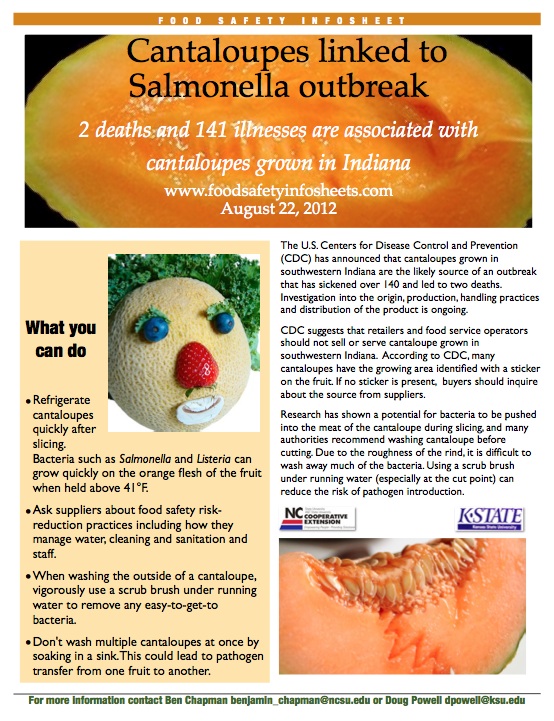I love cantaloupe. It’s probably my favorite fruit. We buy one every couple of weeks, wash the outside with a scrub brush, cut it up and keep it in the fridge (which I have set for 40F) for about 3 days (since Listeria grows, although slowly, at refrigeration temperatures, I started paying attention to how long we kept it after the 2011 Jensen Farms-linked outbreak).
On Friday, CDC announced the investigation into a cluster of salmonellosis illnesses tied to Southern Indiana-grown cantaloupes. Attached to that announcement was a list of consumer recommendations:
Consumers who recently purchased cantaloupes grown in southwestern Indiana are advised not to eat them and discard any remaining cantaloupe..jpg)
Based on the available information, consumers can continue to purchase and eat cantaloupes that did not originate in southwestern Indiana.
Many cantaloupes have the growing area identified with a sticker on the fruit. If no sticker is present, consumers should inquire about the source. When in doubt, throw it out.
Consumers who are buying or have recently bought cantaloupe should ask their retailer if the cantaloupe was grown in southwestern Indiana.
Yesterday, I was just a regular taking-my-kids-shopping patron of a grocery store. One that wanted some cantaloupe. I decided to do a bit of reality research (n=1) and follow the consumer recommendations from the perspective of a non-food safety nerd. I checked the sticker on one of the cantaloupes in the bin and it said:
"S&S Stamoules Produce, Product of USA" (right, exactly as shown).
Nothing about the region or anything. I tried to google the producer’s name to see where they were located – but I didn’t have cell coverage.I asked the kid stocking the produce section. He said he didn’t know.
So I left empty-handed.
I didn’t bother enquiring about the cantaloupe we purchased two weeks ago.
When I got home I went back to trusty Google and found that Stamoules Produce is located in California’s San Joaquin Valley (and has a food safety section on their website where they focus exclusively on pesticides – no mention of good ag practices or whether they clean and sanitize their production line). I’ll have to remember that next time.


.jpg)